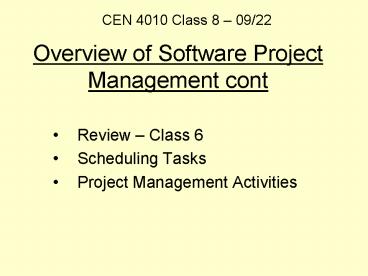Overview of Software Project Management cont PowerPoint PPT Presentation
Title: Overview of Software Project Management cont
1
Overview of Software Project Management cont
CEN 4010 Class 8 09/22
- Review Class 6
- Scheduling Tasks
- Project Management Activities
2
Overview of S/W Project Management
- Software engineering is a collaborative effort.
Involves domain experts, analysts, designers,
programmers, managers, etc.. - Communication is essential!
- Definitions
- Communication mode - a type of information
exchange that has defined objectives and scope. - Communication mechanism - a tool or procedure
that can be used to transmit and receive
information and support a communication mode.
3
Overview of S/W Project Manag. cont
- Modes of communication
- Scheduled Problem defn., client reviews,
project reviews, inspection/walkthroughs, status
review, brainstorming, releases, postmortem. - Event-driven Request for clarification, request
for change, issue resolution. - Go through Tables 3.1 and 3.2
4
Overview of S/W Project Manag. cont
- Mechanisms of communication
- Synchronous Hallway conversations,
questionnaires and structured reviews, meetings,
same-time, and different-place groupware. - Asynchronous Email, newsgroups, WWW, and Lotus
Notes.
5
Overview of S/W Project Manag. cont
- Meetings
- Primary facilitator responsible for
- organizing the meeting and guiding its execution.
- writing the agenda describing the objective and
the scope of the meeting. - Minute taker responsible for recording the
meeting i.e. information for the diary. - Time keeper responsible for keeping track of
time and notifying the facilitator if a
discussion consumes more time than is allocated.
A vote might be required to continue discussion
or move on to the next point.
6
Tasks
- Recall, a task is an atomic unit of work that can
be managed and that consumes resources. - A task includes a description, a duration, and is
assigned to a role. - Tasks are related by dependencies.
- Tasks dependencies are relationships between
individual tasks and time. - Task constraints can be used to make sure a
project is on schedule. - See Table 3-4 and Figure 3-21 and 3-23
7
Schedule
- A task model contains the tasks, their
dependencies, their constraints, and their
planned duration. - A schedule is the mapping of tasks onto time
Each task is assigned planned start and end
times. - Common notations
- Bar chart - Gantt charts
- Activity network PERT chart.
8
Schedule Notation
- Gantt chart
- is a bar chart where the horizontal axis
represents time and the vertical axis the
different tasks to be done. - tasks are represented as bars whose length
correspond to the planned duration of the task. - PERT Chart
- is an acyclic graph of tasks that represents a
schedule. - The minimum time required to finish the project
can be estimated by considering the longest path
(in days) in the activity graph (the critical
path)
9
Schedule Notation cont
- PERT Chart cont
- tasks on the critical path are the most
important. That is, a delay in any of these
tasks will result in a delay in the overall
project. - Properties of Gantt and PERT charts
- useful tools for planning a project and tracking
its execution. - models are only as good as the estimations they
represent. - accurate estimation usually comes with
experience. - can represent tasks to be done in parallel.
10
Developing a Schedule
- Identify tasks to be completed i.e. work
breakdown - Estimate duration for each task in days.
- State any dependencies between tasks.
- Create a table with the above information.
- Use information in table to create a Gantt or
PERT chart.
11
Developing a Schedule - Example
Task Duration (days) Dependencies
T1 4
T2 6 T1
T3 10
T4 12 T2, T3 (M1)
T5 8 T3
T6 6 T4, T5 (M2)
T represents a task M represents a
milestone
12
Developing a Schedule Example cont
Task Name Duration September September September September September September September October October October October October October October October
18 20 22 24 26 28 30 2 4 6 8 10 12 14 16
Start Start
T1 4
T2 6
M1
T3 10
T4 12
M2
T5 8
T6 6
Finish Finish
Gantt Chart
13
Developing a Schedule Example cont
Critical path in green.
Are there any other critical paths?
T1
T2
1
4d
2
6d
09/18
09/21
09/22
09/27
09/18
09/27
Start
T4
M1
T3
4
12d
3
10d
09/22
10/09
T6
10/09
09/18
09/27
6
6d
M2
10/10
10/15
T5
5
8d
09/28
10/09
PERT Chart
10/15
Finish
14
Project Management Activities
- Proposal writing
- Project planning and scheduling
- Project costing
- Project monitoring and reviews
- Personnel selection and evaluation
- Report writing and presentations
- (Sommerville 2001)
15
Project Plan
- Introduction Briefly describes the project, and
sets out the constraints. - Project organization how people on the team are
organized i.e., roles. - Risk analysis describes possible risks e.g. h/w
unavailability, requirements change, technology
change etc. - Hardware and software requirements describes
the h/w and s/w required to carry out the
development.
16
Project Plan cont
- Work breakdown identification of milestones and
deliverables. - Project schedule describes dependencies between
activities, estimation of time required to reach
each milestone and deliverable. - In your report (Deliverable 1) there should be a
section named Project Plan consisting of at
least introduction, project organization, h/w
and s/w requirements, work breakdown and project
schedule.

